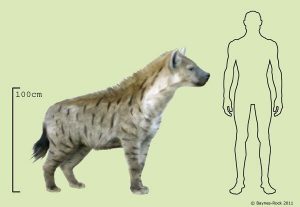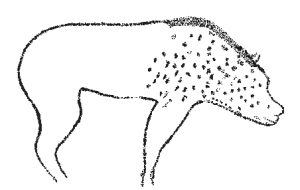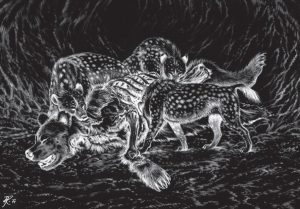(Nikara, Lair ScavengerNikara, Lair Scavenger & Yannik, Scavenging SentinelYannik, Scavenging Sentinel | Art by Grzegorz Rutkowski)
Harley Quinn's Favorite Pet
Today on Historically Speaking, we're going to be doing a deeper dive into fictional and real art history, biology and our new legendary Hyena, courtesy of Commander 2020: Yannik! Oh, and Yannik's incredibly gothy friend, who rests idly on a staff made out of bones. I'm not an Abzan player by inclination, but seeing Nikara and Yannik may have just changed that.
This article is an exploration of the plane of Ikoria, which for all intents and purposes, could be pitched as: 'The Pleistocene epoch, but with magic, fascist humans, and kaiju." So an examination of real-life human-hyena relations seems like a good idea, and it involves a fascinating bit of history, the study of bones, and even some cave art (although the mythos-cycle will have to wait for it's own in-depth article). Oh, and while I'm not an obsessive deck-builder, I would love to hear how you all would use this prehistoric pair. Leave your favorite mini-combo with this pair in the comments below!
Nikara's reliance on bones is appropriate, given that much of what we know about human-hyena interaction outside of Africa, specifically in the Pleistocene-era, comes from the study of bones. Specifically, what we know about prehistoric megafauna, given that human beings lived alongside and competed with hyenas, sabertooth cats, cave bears and wolves for millions of years.
First, a quick aside about what exactly Yannik is. While her technical creature type is 'Hyena Beast' - and Ikoria is a plane that encourages random mutations - this doesn't mean much. The beast creature type, as we all know, is just a catch-all term Wizards of the Coast uses when they want to make a creature green and hit hard, but don't want to define too much about what it is. Allow me to demonstrate:
I rest my case. The Vorine is a Cat Beast, the Baloth is reptilian, and the Warchief is just a confusion of spikes with a creature type on it. Anyway, rant over.
It is most likely that Yannik is no ordinary hyena. I believe she is a representation - the first in Magic: the Gathering history - of a cave hyena.
So if scaling is any guide, Yarrik is 200-300 pounds, lion-sized. Right in the weight class of an apex predators.
And, you know, her art shows her emerging from a cave with her partner's bone-staff in her jaws. Cave hyena seems an obvious choice for her. Cave hyenas weren't technically a separate species from today's spotted hyenas, but a larger version adapted to the Eurasian grass-lands, as recent DNA testing has showed. Think of a modern spotted hyena hit by a giant growth.
Lynette Summerill describes cave hyenas like this:
“Prehistoric hyenas had an overall body mass comparable to humans. They boasted razor-sharp teeth and powerful bone-crushing jaws. Scientists say they were probably the most dangerous non-human animal in the late Pleistocene period. Some researchers think that ancient hyenas may have hunted in packs as large as 40 to 50 animals. They were the ultimate scavengers, and might have easily stolen a big game kill from human hunters."
Summerill's interviewee, Turner, posits that it is in fact possible that the concentrations of cave hyenas in Siberia during the Pleistocene may have delayed human migration across the Bering strait to the New World until humans domesticated dogs to counter the threat, saying:
“We’ve wondered whether the presence of hyena packs and other large carnivores played a significant role in limiting human northward expansion into the western Bering Straits region,” Turner says. “The domestication of dogs might have finally aided humans to successfully defend against marauding hyena packs. A dog skull dating back to 14,000 years ago supports that theory. The skull was found at Razboinichiya Cave in the Siberian Altai mountains."
This brings us, of course to human-hyena relationships, which despite that grim sentence above, may not have been entirely adversarial (and certainly aren't in Ikoria).
Nikara's friendship with Yannik is less unlikely than one might suspect. According to Summerill's interview, it is possible that some humans and hyenas cooperated - or at least tolerated each other.
"Other scientists have different ideas[than Turner]. Nicolai Ovodov, Turner’s Russian colleague, thinks that the giant hyenas and humans may have had some kind of positive symbiotic relationship. He thinks they may have shared food, and possibly shelter."
And in the dog-eat-mutant-dog setting of Ikoria, such a partnership between human and hyena (pardon the pun) makes perfect sense. This could have roots in how humans, wolves and hyenas - all endurance predators competing for large hoofed mammals - divided themselves. Wolves favored the mountains and forests, according to Spiner's paper on the three species in Pleistocene Italy, while hyenas favored low altitude grass-lands and humans the zones in-between the two.
This allowed all three of them to compete for the same resources without necessarily coming into excessive competition. Wolves hunted ibex in the mountains, while hyenas showed a slight preference for horses - and all three species hunted red deer.
But of the three species, according to what bones we've found - in caves, of course - of prey animals, only humans deliberately hunted prey in their prime, rather than favoring the old or weak as wolves and hyenas did. All three species cracked bones for marrow, an important source of protein, but scientists can distinguish between human hammer-tools and hyena's jaws and these bones leave an important record of dietary preference and geography. For a hyena, teaming up with the only species that hunts the largest and strongest of the prey animals has obvious dietary advantages.
But, as the climate in the Pleistocene changed and the grasslands changed to mixed forests, the hyenas were out-competed by people and wolves in the long run. Eventually hyenas retreated back onto the African continent, where there were vast grasslands and enough megafauna to suit them.
In Ikoria, obviously, this transition away from mega-fauna and the open plains hasn't happened. Instead of shrinking and vanishing, clearly, the cave hyena is alive and well (and with antlers). And man has a new best friend.
I try not to dip my big toe too much into card synergies, but can we just note that Yannik has the ability to functionally 'eat' creatures that even the most determined hyena would think twice about? Some wonderful examples:
Yes, Yannik can eat block-spanning monsters, whole trains or avatars of god-like planeswalkers with ease. I like to imagine her distribution of +1/+1 counters is her plucking the individual bones out of the creature she exiles, and then running back and forth distributing these tokens to her teammates. It obviously gets messy when she vanishes and the creature reconstitutes, but hey, lets not think too hard about that - or how they regrew their bones. Shush, shush, a wizard did it.
I'll be back soon with the penultimate episode of my Tarkir-series--following the misadventures of Zurgo Helmsmasher's attempt to recreate the Mongol Empire--though the Sultai Brood might have something to say about that.
Sources:
Bon, C.; Berthonaud, V.; Maksud, F.; Labadie, K.; Poulain, J.; Artiguenave, F.; Wincker, P.; Aury, J.-M.; Elalouf, J.-M. (2012). "Coprolites as a source of information on the genome and diet of the cave hyena". Proceedings of the Royal Society B: Biological Sciences. 279(1739): 2825–2830. doi:10.1098/rspb.2012.0358. PMC 3367792. PMID 22456883.
C. Stiner, Mary (2004) Comparative ecology and taphonomy of spotted hyenas, humans, and wolves in Pleistocene Italy, Revue de Paléobiologie, Genève. (December 2004) 23 (2) : 771-785. ISSN 0253-6730
Summerill, Lynette Gnawed Bones Tell Tales Summer issue, ASU Research Journal 2003.
Charles Allison
I'm from just north of hell, I was schooled in a blossoming backwater, and currently am the worst living bureaucrat since Franz Kafka breathed his last, tremulous breath. I’ve been playing Magic: The Gathering since middle school, and Commander in particular since college, putting about a decade of experience brewing, scheming and fuming over historical travesties under my belt. I get dizzy walking in straight lines. I recently received my MFA from Arcadia University's creative writing program. My work has previously appeared in Podcastle, Stonecoast Review, Devilfish Review and Bride of Chaos.
Your opinions are welcome. We love hearing what you think about Magic! We ask that you are always respectful when commenting. Please keep in mind how your comments could be interpreted by others. Personal attacks on our writers or other commenters will not be tolerated. Your comments may be removed if your language could be interpreted as aggressive or disrespectful. You may also be banned from writing further comments.



